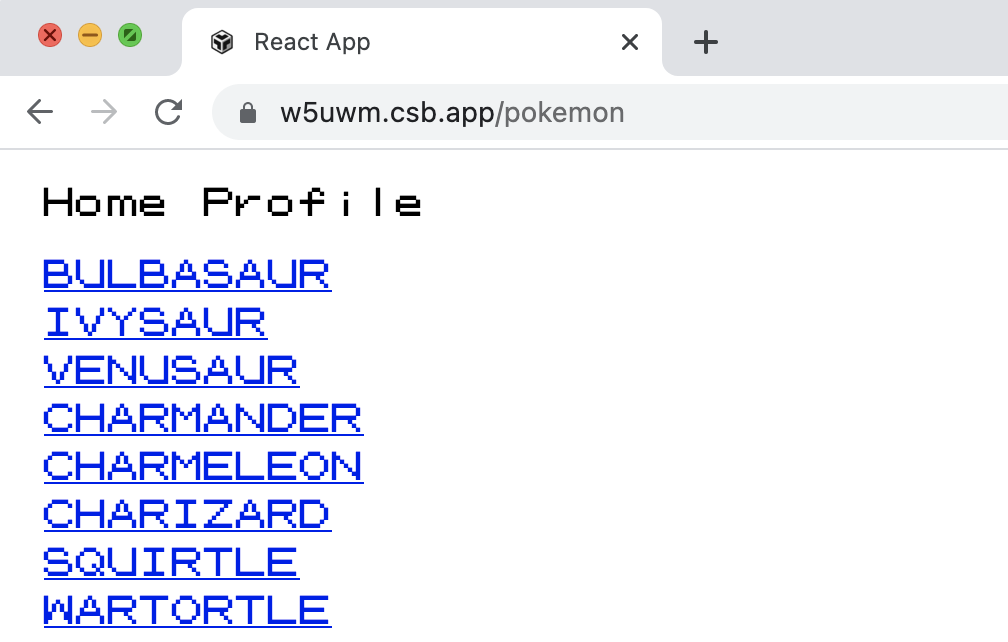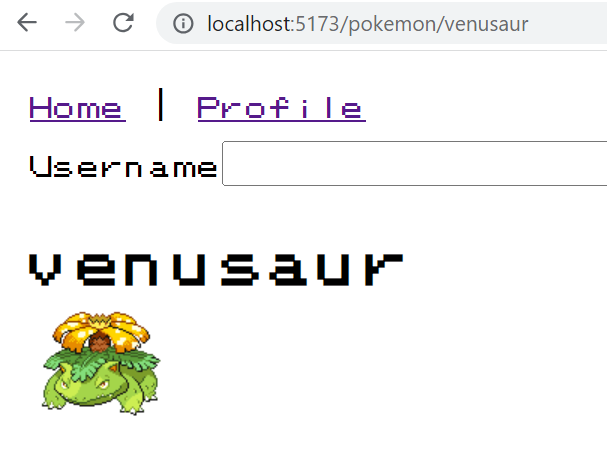Routing
Essential React
So far our Pokedex app only has a single page.
Let's make this more interesting…

Let's make this more interesting…

Routing
We want to define distinct pages within our application.
The current page at a given time is defined by the URL of the browser tab.
The URL can contain parameters which are used by a page to show specific data.
React does not provide routing.
The most popular routing library in the React ecosystem is React Router.
Basic Routing with React Router
Install the Package
npm install react-router-domHow to Define Routes
function App() { return ( /* Let's route! */ ); }
How to Define Routes
import { RouterProvider, createBrowserRouter } from "react-router-dom"; const router = createBrowserRouter([]); function App() { return ( <RouterProvider router={router} /> ); }
createBrowserRouter creates an instance of a router that will be used.
How to Define Routes
import { RouterProvider, createBrowserRouter } from "react-router-dom"; import { Page1 } from "./Page1.tsx"; const router = createBrowserRouter([ { path: '/page1', element: <Page1 /> }, ]); function App() { return ( <RouterProvider router={router} /> ); }
Here we define a route with the path /page1 and tell it to render the Page1 component .
How to Define Routes
import { RouterProvider, createBrowserRouter } from "react-router-dom"; import { Page1 } from "./Page1.tsx"; import { Page2 } from "./Page2.tsx"; const router = createBrowserRouter([ { path: '/page1', element: <Page1 /> }, { path: '/page2', element: <Page2 /> }, ]); function App() { return ( <RouterProvider router={router} /> ); }
Page1.tsx
export function Page1() { return <p>This is page 1.</p>; }
The "page" is just a normal React component.
Routes with Parameters
const router = createBrowserRouter( […, {path: '/cars/:carId', element: <CarDetailPage/>}]);
This route has a parameter carId .
Routes with Parameters
CarDetailPage.tsx
import { useParams } from "react-router-dom"; export function CarDetailPage() { const { carId } = useParams<"carId">(); return <p>This is the car with the ID {carId}.</p>; }
import { useParams } from "react-router-dom"; export function CarDetailPage() { const { carId } = useParams<"carId">(); return <p>This is the car with the ID {carId}.</p>; }
The useParams Hook returns the parameters of the current route as an object.
Route Redirection
import { RouterProvider, createBrowserRouter, Navigate } from "react-router-dom"; import { RouterProvider, createBrowserRouter } from "react-router-dom"; import { Page1 } from "./Page1.tsx"; import { Page2 } from "./Page2.tsx"; const router = createBrowserRouter([ {path: '/', element: <Navigate to="/page1" replace />}, {path: '/page1', element: <Page1/>}, {path: '/page2', element: <Page2/>} ]); function App() { return ( <RouterProvider router={router} /> ); }
With the Navigate component, a route can be redirected to another route.
With using the replace prop, no entry will be added to the browser history.
How to Link to a Route
import { Link } from "react-router-dom"; function NavBar() { return ( <p> <Link to="/page1">Page 1</Link> | <Link to="/page2">Page 2</Link> </p> ); }
import { Link } from "react-router-dom"; function NavBar() { return ( <p> <Link to="/page1">Page 1</Link> | <Link to="/page2">Page 2</Link> </p> ); }
Cheat Sheet
const router = createBrowserRouter([...]);
<RouterProvider router={router} />
{path: '/cars/:carId', element: <Car/>}
<Navigate to="/cars" replace />
<Link to="/cars/42">Go to Car 42</Link>
Exercise
-
Split the app up into two navigatable pages:
- The Home page shows the list of pokemon.
- When clicking on a pokemon in the list, the pokemon detail page is shown.
-
Use the mock data provided in the github repository
https://github.com/webplatformz/react-pokedex-vite/tree/chapter-05-routing/src/mockData


Stretch Goal
Think about what to do with the username input and display functionality.
Can we have the input on a Profile page but show the name on all pages?
Solution
App.tsx
const router = createBrowserRouter([{ path: "/", element: <Navigate to="/pokemon" replace />, }, { path: "/pokemon", element: <ListPage />, }, { path: "/pokemon/:pokemonName", element: <DetailPage />, }]); function App() { return <RouterProvider router={router} />; }
const router = createBrowserRouter([{ path: "/", element: <Navigate to="/pokemon" replace />, }, { path: "/pokemon", element: <ListPage />, }, { path: "/pokemon/:pokemonName", element: <DetailPage />, }]); function App() { return <RouterProvider router={router} />; }
const router = createBrowserRouter([{ path: "/", element: <Navigate to="/pokemon" replace />, }, { path: "/pokemon", element: <ListPage />, }, { path: "/pokemon/:pokemonName", element: <DetailPage />, }]); function App() { return <RouterProvider router={router} />; }
const router = createBrowserRouter([{ path: "/", element: <Navigate to="/pokemon" replace />, }, { path: "/pokemon", element: <ListPage />, }, { path: "/pokemon/:pokemonName", element: <DetailPage />, }]); function App() { return <RouterProvider router={router} />; }
const router = createBrowserRouter([{ path: "/", element: <Navigate to="/pokemon" replace />, }, { path: "/pokemon", element: <ListPage />, }, { path: "/pokemon/:pokemonName", element: <DetailPage />, }]); function App() { return <RouterProvider router={router} />; }
const router = createBrowserRouter([{ path: "/", element: <Navigate to="/pokemon" replace />, }, { path: "/pokemon", element: <ListPage />, }, { path: "/pokemon/:pokemonName", element: <DetailPage />, }]); function App() { return <RouterProvider router={router} />; }
Layout.tsx
import { Link } from "react-router-dom"; import { PropsWithChildren } from "react"; type LayoutProps = PropsWithChildren; export function Layout({ children }: LayoutProps) { return ( <div> <header> <nav> <Link to="/">Home</Link> | <Link to="/profile">Profile</Link> </nav> </header> <main>{children}</main> </div> ); }
ListPage.tsx
import { Layout } from "../../components/layout/Layout"; import { PokeList } from "../../components/poke-list/PokeList"; import { pokemonList } from "../../mockData/list"; function ListPage() { return ( <Layout> <PokeList pokemons={pokemonList.results} /> </Layout> ); } export { ListPage };
PokeListEntry.tsx
import { Link } from "react-router-dom"; interface PokeListEntryProps { name: string; } export function PokeListEntry({ name }: PokeListEntryProps) { return ( <li> <Link className="uppercase" to={`./${name}`}> {name} </Link> </li> ); }
import { Link } from "react-router-dom"; interface PokeListEntryProps { name: string; } export function PokeListEntry({ name }: PokeListEntryProps) { return ( <li> <Link className="uppercase" to={`./${name}`}> {name} </Link> </li> ); }
DetailPage.tsx
import { useParams } from "react-router-dom"; import { pokeDetails } from "../../mockData/details"; import { Layout } from "../../components/layout/Layout"; function DetailPage() { const { pokemonName } = useParams<"pokemonName">(); const pokemon = pokeDetails.find((p) => p.name === pokemonName); return ( <Layout> <h1 className="uppercase">{pokemonName}</h1> <img src={pokemon?.sprites.front_shiny} alt={pokemonName} /> </Layout> ); } export { DetailPage };
import { useParams } from "react-router-dom"; import { pokeDetails } from "../../mockData/details"; import { Layout } from "../../components/layout/Layout"; function DetailPage() { const { pokemonName } = useParams<"pokemonName">(); const pokemon = pokeDetails.find((p) => p.name === pokemonName); return ( <Layout> <h1 className="uppercase">{pokemonName}</h1> <img src={pokemon?.sprites.front_shiny} alt={pokemonName} /> </Layout> ); } export { DetailPage };
import { useParams } from "react-router-dom"; import { pokeDetails } from "../../mockData/details"; import { Layout } from "../../components/layout/Layout"; function DetailPage() { const { pokemonName } = useParams<"pokemonName">(); const pokemon = pokeDetails.find((p) => p.name === pokemonName); return ( <Layout> <h1 className="uppercase">{pokemonName}</h1> <img src={pokemon?.sprites.front_shiny} alt={pokemonName} /> </Layout> ); } export { DetailPage };
import { useParams } from "react-router-dom"; import { pokeDetails } from "../../mockData/details"; import { Layout } from "../../components/layout/Layout"; function DetailPage() { const { pokemonName } = useParams<"pokemonName">(); const pokemon = pokeDetails.find((p) => p.name === pokemonName); return ( <Layout> <h1 className="uppercase">{pokemonName}</h1> <img src={pokemon?.sprites.front_shiny} alt={pokemonName} /> </Layout> ); } export { DetailPage };
import { useParams } from "react-router-dom"; import { pokeDetails } from "../../mockData/details"; import { Layout } from "../../components/layout/Layout"; function DetailPage() { const { pokemonName } = useParams<"pokemonName">(); const pokemon = pokeDetails.find((p) => p.name === pokemonName); return ( <Layout> <h1 className="uppercase">{pokemonName}</h1> <img src={pokemon?.sprites.front_shiny} alt={pokemonName} /> </Layout> ); } export { DetailPage };
More about React Router
NavLink
function MyComponent() { return (<> // … <NavLink to="/faq" className={({ isActive }) => isActive ? "activated" : ""} > FAQs </NavLink> </>); }
A NavLink is marked with the specified CSS class/style when its route is active.
Nested Routes
const router = createBrowserRouter([ { path: "/", element: <Layout />, children: [ { path: "pokemon", element: <ListPage />, }, { path: "pokemon/:pokemonName", element: <DetailPage />, }, ], }, ]); function App() { return <RouterProvider router={router} />; }
const router = createBrowserRouter([ { path: "/", element: <Layout />, children: [ { path: "pokemon", element: <ListPage />, }, { path: "pokemon/:pokemonName", element: <DetailPage />, }, ], }, ]); function App() { return <RouterProvider router={router} />; }
Nested Routes
function Layout() { return (<div> {/* Navbar… */} <Outlet /> </div>); }
useLocation
Current URL: /cars?filter=Tesla
function MyComponent() { const { pathname, search } = useLocation(); console.log(`Pathname: ${pathname}`); /* Pathname: /cars */ console.log(`Query string: ${search}`); /* Query string: ?filter=Tesla */ /* … */ }
Returns the location object representing the current URL.
useNavigate
function MyComponent() { const navigate = useNavigate(); return <button onClick={() => { // Do something navigate('/home'); }}> Do something and then go to Home </button> }
Navigate programmatically
MemoryRouter
import { RouterProvider, createMemoryRouter } from "react-router-dom"; const router = createMemoryRouter(routes, { initialEntries: ["/", "/events/123"], initialIndex: 1, }); function MyComponent() { return <RouterProvider router={router} />; }
Use instead of BrowserRouter for tests.
Recap
We learned…
- How to define routes
- How to define routes with parameters
- How to redirect routes
- How to link to a route
- Further useful React Router features